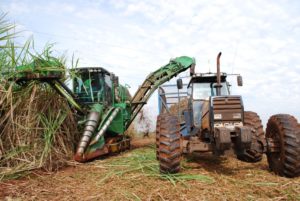At 332,000,000, more cars are on the road in China than anywhere in the world. Today, most run on pure petrol, but from next year Chinese fuel companies will add 10% ethanol, with potentially far reaching implications for the consumption of fossil fuels.
The enormous potential of the Chinese consumer market has energised Brazil’s biofuel industry, the world’s second largest behind the US. The industry, which in recent years has suffered from fuel price shocks resulting from shifts in government policy, has been buoyed by the potential of the Chinese market.
There is the risk of trading one problem, fossil fuels, for one that is much worse: deforestation
Furthermore, in May, China and Brazil resolved a Brazilian complaint to the World Trade Organisation (WTO) about Chinese tariffs on sugar, paving the way for greater imports. Brazilian farmers also expect the agreement to open the door for more Brazilian ethanol.
While environmentalists are optimistic that adding ethanol to Chinese petrol will massively cut greenhouse gas emissions, they are wary about other repercussions. The biofuel industry requires large maize and sugarcane plantations, which can encroach on forests.
“There is the risk of trading one problem, fossil fuels, for one that is much worse: deforestation,” said Ricardo Junqueira Fujii, a conservation analyst at NGO WWF-Brazil.
He added that the country’s potential to produce low-carbon fuel could double without compromising food production.
Now, Brazilian society and the government have a responsibility to define adequate public policies for land use and conservation of the Amazon, Cerrado, and other Brazilian biomes, Fujii said.
Cleaner fuel
The Chinese government announced the new biofuel quota in September 2017 as part of its commitment to reduce fossil fuel consumption under the Paris Agreement on climate change.
“Adding it increases the degree of octane in the fuel, improving mileage, it avoids the use of heavy metals (especially lead), and reduces global carbon dioxide emissions,” said ldo Sauer of the University of São Paulo.
However, planting crops to produce ethanol can bring about a change in land use, Brazil’s main source of emissions.
compliance with environmental regularisation programmes, where farmers present their plans to resolve any identified environmental risks, is low
Since 2009, Brazil has had a process of Agro-Ecological Sugarcane Zoning, which blocks cane fields from encroaching onto indigenous lands or areas of native vegetation. It can only be planted on degraded pastures.
However, the ruralista agribusiness caucus in Brazil’s legislature has pushed for changes.
In 2017, Senator Flexa Ribeiro proposed a bill to clear land in the Cerrado savannah and grassland areas within the Amazon region. Protests from environmentalists and even some farmers eventually led to the proposal being shelved last year.
Yet, the region earmarked for sugarcane expansion is not the Amazon but the area known as Matopiba that straddles the states of Maranhão, Tocantins, Piauí, and Bahia in the Cerrado, which is already impacted by the expansion of soy farming.
Oversight agencies are struggling to keep pace with developments as they are still fighting to implement existing protective measures.
In 2014, the Brazilian government started implementing a rural environment registration programme for farmers to register their land, thereby making it easier for law enforcement to trace illegal deforestation on private property. Five years later, however, many farms are still unregistered.
“The deadline for rural environment registration has been delayed several times, and compliance with environmental regularisation programmes, where farmers present their plans to resolve any identified environmental risks, is low,” said Fujii.
33,100,000
Brazil’s domestic ethanol production for the 2018/2019 season in tonnes.
There are also concerns about work. Today, the harvest is mostly mechanised, which has significantly reduced slave labour in cane fields but increased unemployment in rural areas.
According to the University of São Paulo’s Centre for Advanced Studies in Applied Economics (CEPEA), cane production formally employs approximately 750,000 people, in Brazil, some 42% fewer than the 1,283,258 formal workers registered in 2008.
Eduardo Leão, executive director of the Brazilian Sugarcane Industry Association (UNICA), told Diálogo Chino that the overall economic benefits are undeniable.
“The sugarcane energy sector is an important source of employment and income. In each municipality where a plant is installed, the per capita income increases by US$1,000 per year,” he said.
Brazil’s challenges
Despite China’s integration of ethanol creating optimism in Brazil, market observers are cautious as the trade could yet be affected by a recent cooling in US-China trade tensions and other factors.
China is expected to consume 15 million tonnes of biofuels in the coming year. The country currently has the capacity to produce approximately 3 million tonnes annually, a figure that could hit 5 million in 2020, according to market data provider IHS Markit.
This would leave a shortfall of around 10 million tonnes, which could allow Brazil, whose largest trading partner is China, to become a leading supplier. Brazil’s domestic ethanol production for the 2018/2019 season was around 33.1 million tonnes.
Artur Yabe Milanez, head of biofuels at Brazilian development bank BNDES, said:
“The prospects are excellent. For years Brazil has tried to open the Chinese market to ethanol, and it appears that the efforts are now paying off.”
Brazil is also capable of producing diverse biofuel crops and is turning to maize as an alternative to sugarcane, which has traditionally been used for domestic production.
“The sector receives large investments, especially in Mato Grosso and Goiás, including [for] flex mills that run on maize and sugarcane,” explains Ricardo Tomczyk, president of the National Union of Maize Ethanol (UNEM).
Tomczyk added that China is making preparations to produce its own ethanol from imported raw materials but there may be limits to its production capacity, which would create opportunities for Brazil”, says Tomczyk.
However, competition with other countries is intense. Currently, the US is China’s main ethanol supplier, and a recently declared truce in the long-running trade war could strengthen cooperation between the two countries in the biofuels sector.
“The US will want a slice of the ethanol market, which certainly is on the negotiating table for a truce,” Sauer said.
Food vs. fuel
Experts remain cautious following the sector’s past ups and downs, which have historically been linked to food price fluctuations.
1938
the year Brazil mandated the addition of ethanol to petrol
“The addition of ethanol to petrol has been mandatory in Brazil since 1938, and since that time there has been bargaining with sugarcane producers,” Sauer said. “When sugar prices on the international market were bad, there was pressure to increase the level of ethanol in petrol, and this still happens today”
Following a biofuels boom a decade ago that coincided with a spike in global food prices, there is still some unease about the industry.
A recent UN Food and Agriculture Organisation (FAO) report highlighted how biofuels can drive up crop prices when oil prices rise.
Today, however, the debate is less heated than in 2012, when then FAO chief José Graziano da Silva, said the use of corn for ethanol in the US was increasing grain prices the world over. He later softened his stance.
“We need to move from the food versus fuel debate to a food and fuel debate. There is no question: food comes first,” Graziano said in 2015. “But biofuels should not be simply seen as a threat or as a magical solution. Like anything else, they can do good or bad.”




